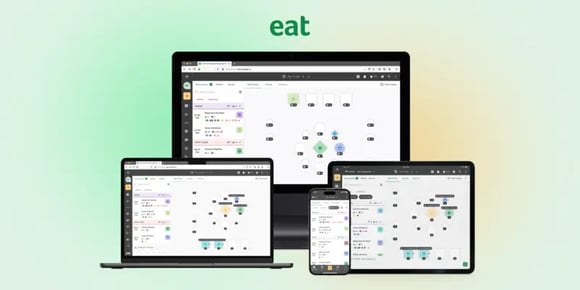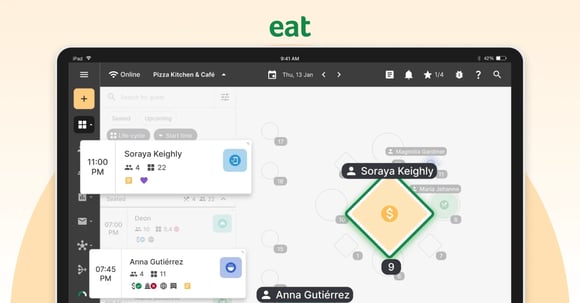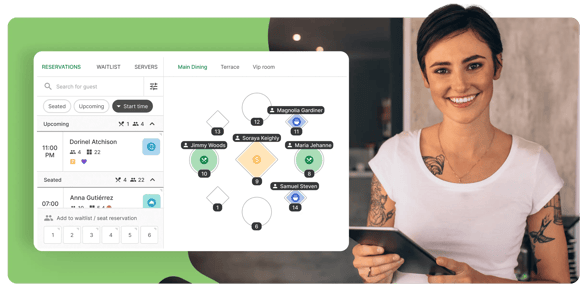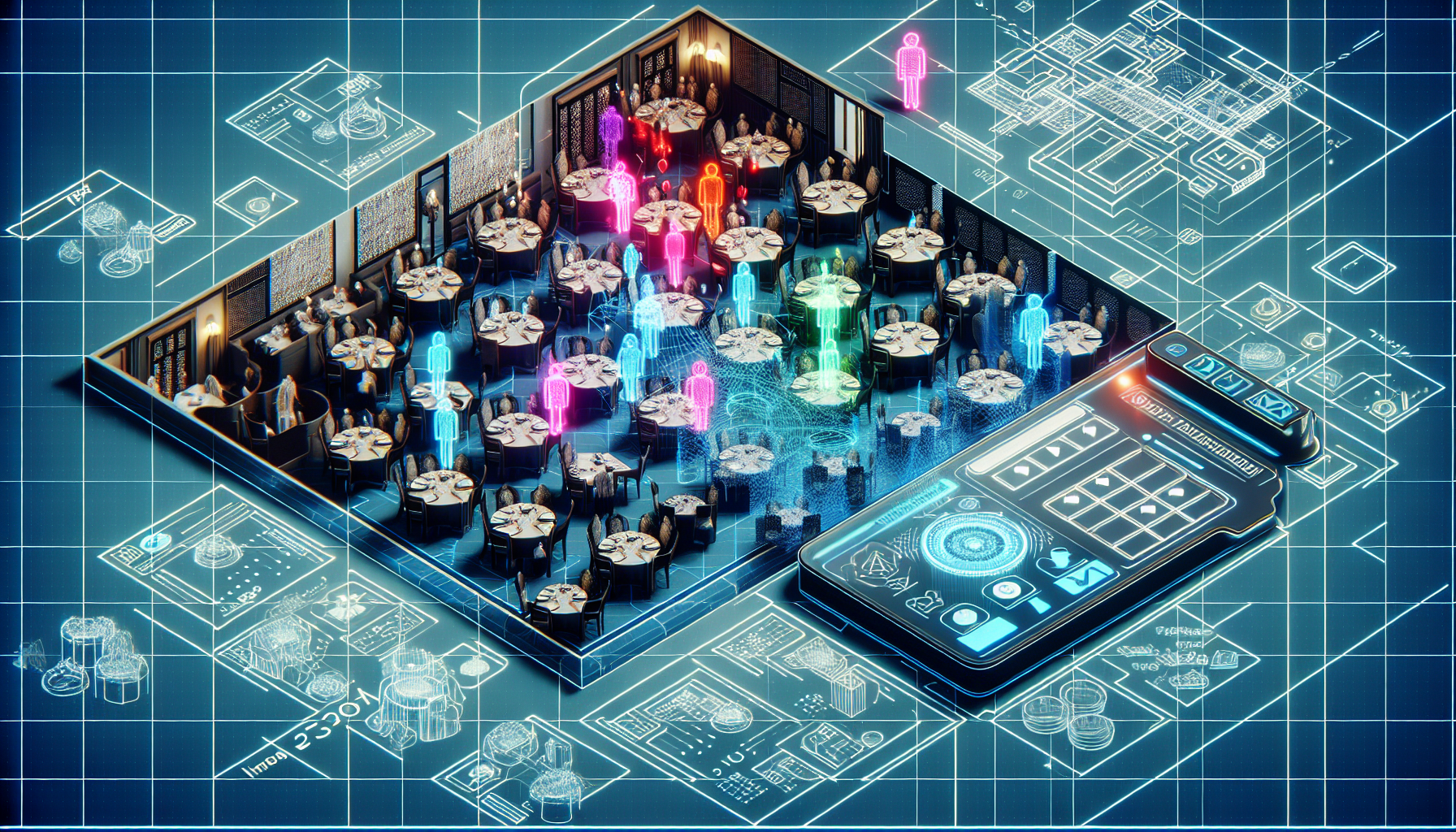A restaurant table management system, often asked as “What is a restaurant table management system?”, is an essential tool designed to coordinate the allocation of dining tables, optimize seating, manage reservations, and track the status of each table in real-time.
These systems facilitate smoother service, improve guest experience, and increase operational efficiency in a busy restaurant environment.
Demystifying restaurant table management systems

A restaurant table management system offers several benefits for the restaurant industry:
-
Streamlines the management of reservations, table assignments, and dining room layouts
-
Provides real-time data on table availability
-
Improves operational efficiency
-
Enhances the dining experience
But the benefits don’t stop there. These systems also equip staff with the right tools to improve guest service, such as efficiently assigning tables and managing waitlists.
And with proper staff training on the system, its full potential can be leveraged, improving the dining experience even further.
Further reading
Understanding table management software
Table management software goes beyond just managing table reservations. It’s a comprehensive tool that enables real-time tracking and updates on table availability.
A robust table management system facilitates reservation handling by managing guest information, tracking reservation statuses, and capturing guest details, including party sizes and special requests.
Furthermore, it allows for customizable table and seating arrangements that cater to varying event types and individual guest preferences, enhancing the dining experience.
Learn more about
The role of table management in a successful restaurant
The role of efficient table management in a successful restaurant is important.
With efficient seating through table management, the following benefits can be achieved:
-
Shortened wait times
-
Smoother dining experiences
-
Increased service speed
-
Higher table turnover rates
By managing table availability, tracking status, and assigning tables to customers efficiently, guest wait times are reduced, and the guest flow is improved.
This, coupled with quicker seating and table turnovers, substantially enhances a restaurant’s overall performance, particularly during peak hours.
Key components of a restaurant table management system

Every restaurant table management system comes with essential features that make it a must-have for any restaurant.
These include:
-
Real-time updates on table availability
-
Seating arrangements
-
Reservation management
-
Waitlist management
-
Custom floor plans
The system aids in organizing the restaurant’s floor plan and managing the efficient rotation of seating for reservations and walk-ins, improving the overall dining experience.
Another important aspect is real-time floor plan visualization.
This allows for monitoring table occupancy, making quick seating decisions, maximizing space, and enhancing the dining experience for customers.
Plus, these systems come with critical reporting capabilities, including monitoring real-time table utilization, waitlist status, and analyzing seating patterns to improve restaurant performance.
Reservation and waitlist coordination
A key aspect of any restaurant table management system is its reservation and waitlist coordination features.
These include:
-
Handling table reservations
-
Maintaining guest information
-
Managing virtual waitlists with SMS notifications
-
Real-time tracking capabilities for guests
By providing real-time status updates, table management systems are key in accurately estimating table availability and wait times for guests.
This leads to more efficient seating arrangements and reduced guest wait times, improving overall restaurant operations.
Real-time floor plan visualization

The ability to visualize the restaurant floor in real time is a game-changer.
This tool helps optimize table assignments by considering party size, seating preferences, and table availability.
It streamlines the process for efficient seating arrangement.
With updates on table availability in real-time, table management becomes more efficient, leading to integrated dining operations and a flexible table inventory.
Visual floor plans provided by the table management systems offer several benefits:
-
Efficient table assignments
-
Reduced guest wait times
-
Fewer manual seating errors
-
Real-time reporting capabilities for active monitoring of table utilization and seating patterns
-
Ability to make timely operational adjustments
Integration with POS systems and CRM software
The power of a restaurant table management system is further enhanced when integrated with other restaurant software like POS systems, CRM software, and restaurant management software.
This integration streamlines front-of-house and back-of-house communication and simplifies order processing and billing.
Moreover, it enables restaurants to efficiently manage guest preferences and dining history for better customer relationships.
The ideal system integrates seamlessly with existing POS and CRM tools, ensuring compatibility and uninterrupted data flow.
This seamless integration ensures a holistic view of restaurant operations, reduces manual effort and improve overall efficiency.
Enhancing the guest experience through table management
%20(1).webp?width=580&height=326&name=Eat%20(55)%20(1).webp)
A restaurant table management system does more than just streamline operations; it also significantly enhances the guest experience.
These systems:
-
Track the status of each table
-
Accommodate guest seating preferences by assigning tables based on a variety of factors, including personalized recommendations from past visits
-
Provide features like SMS/text notifications
-
Provide accurate wait time estimates
-
Provide real-time table availability
By providing these features, table management systems reduce perceived wait times and improve the overall efficiency of managing reservations and waitlists.
Moreover, these systems allow for the personalization of the dining experience.
By making use of insights from customers’ dining preferences and history, a deeper connection with guests is fostered, encouraging repeat visits and contributing to a more personalized and memorable dining experience.
Personalizing customer interactions
One of the ways a restaurant table management system enhances the guest experience is by personalizing customer interactions.
These systems track guests’ reservation histories, helping identify regular customers and customizing services to their preferences.
Guest seating preferences are recorded within advanced systems, enabling these preferences to be applied to future reservations for enhanced personalization.
Restaurants can create detailed guest profiles that include dining preferences and allergies, which are used to provide personalized service.
By integrating with loyalty programs, personalized rewards, and experiences are created that foster customer loyalty and encourage repeat visits. These systems also assist in guest communication, creating a tailored communication strategy through customer relationship management.
Managing guest expectations with accurate information
Accurate information is key to managing guest expectations.
Table management systems provide real-time tracking of table statuses, enabling restaurants to:
-
Make quick and accurate decisions regarding guest seating
-
Provide accurate estimations of wait times
-
Communicate updates on the number of tables ahead to guests
This ensures that guests have realistic expectations about being seated.
Automated notifications about reservation statuses and table readiness are sent to guests through SMS and email, enhancing their overall dining experience by keeping them adequately informed.
Optimizing restaurant workflow with table management systems
A restaurant table management system does more than improve the guest experience; it also significantly improves the restaurant workflow.
These systems help optimize the use of dining space by considering factors like party sizes and unique customer requests, resulting in a more evenly distributed workload among staff and a smoother overall dining experience for guests.
Real-time updates on the status of tables allow restaurant operators to manage the ebb and flow of the dining room with greater efficacy, reducing wait times and increasing table turnover rates.
In addition, data analytics and reporting capabilities within these systems provide valuable insights into trends such as peak dining periods, customer preferences, and staff performance.
This facilitates improved service efficiency through informed decision-making.
Streamlining front-of-house operations
%20(1).webp?width=580&height=326&name=Eat%20(54)%20(1).webp)
Alongside improving the guest experience and optimizing restaurant workflow, a table management system also significantly streamlines front-of-house operations.
These systems provide server rotation capabilities, assisting hosts in determining which server is next to receive customers. This leads to a more equitable distribution of tables among the staff.
The mobile functionality of these systems allows staff to access and update table status, manage reservations, and communicate with guests on the move. This increases efficiency and responsiveness for better customer service.
Data-driven decisions for better service efficiency
The benefits of a table management system extend to making data-driven decisions for better service efficiency.
These systems provide detailed analytics and reports, offering insights on:
-
Peak dining times
-
Customer preferences
-
Staff performance
-
Seating capacity
-
Trends in reservations
These insights enhance service efficiency by optimizing table utilization, wait times, and identifying seating trends.
Furthermore, integrating analytics from these systems with sales forecasting tools is necessary for precise staff scheduling, reducing labor costs, and streamlining inventory management.
Integrating table management with other restaurant technologies
A restaurant table management system is not an isolated tool. It becomes even more powerful when integrated with other restaurant technologies.
For example, integrating a Kitchen Display System (KDS) with a table management system enhances operational efficiency by reducing errors and speeding up service.
A table management system can consolidate orders from various sources to display them on the KDS, improving order tracking and kitchen operations.
Pairing a restaurant table management system with other management software creates a cohesive solution that enhances efficiency across all aspects of restaurant operations.
Technologies such as:
-
POS systems
-
Booking platforms
-
Digital menu boards
-
Contactless payment systems
complement the functionalities of a table management system.
Seamless integration with POS and other digital tools is essential for a fluid operational flow from reservations to billing.
The benefits of technology stacks
The integration of a table management system with other technologies, known as a technology stack, has many benefits. It can lower administrative costs by 30% to 40%, streamline order processing, and enhance customer satisfaction.
Restaurants employing technology stacks with integrated systems such as POS, KDS, inventory management, and online reservation systems can streamline operations and manage tasks more effectively.
Moreover, they can increase customer satisfaction by managing prep and firing times efficiently and reducing mistakes through improved communication facilitated by technology integration.
This integration can increase operational efficiency, reduce costs, unlock new sales channels, and improve the customer experience.
Quick-service restaurants, cafes, and food trucks have seen benefits from integrating table management systems with KDS, including the ability to manage multiple menus and built-in kitchen display functions.
Case studies: successful integrations
The proof of the pudding is in the eating, as they say, and the effectiveness of integrating a table management system with other restaurant technologies is evident in real-life case studies.
For example, a restaurant franchise experienced business growth of over 40% by integrating a table management system with online and mobile ordering software.
This integration improved order tracking and customer billing for the restaurant franchise.
Navigating the selection of a restaurant table management system
Choosing the right restaurant table management system is a important decision that requires careful consideration.
The system should:
-
Cater to current demands
-
Possess the capacity to accommodate future growth without needing significant system changes
-
Offer customization options for table arrangements, seating preferences, and system rules to align with the specific requirements and branding of the restaurant
These features contribute to increased operational efficiency and consistent brand portrayal.
Ensuring the chosen system maintains high-security standards is critical to protecting customer data and adhering to privacy regulations.
When selecting a table management system, it’s essential to calculate the total cost of ownership, taking into account all expenses such as initial investment, subscription fees, and potential costs for additional features or updates.
Additionally, assessing the availability and quality of training and support services offered by system providers helps ensure that the restaurant staff can effectively use the system and resolve any issues expediently.
Assessing your restaurant's requirements
Before selecting a table management system, it is vital to assess your restaurant’s requirements. Identifying operational challenges is a crucial first step in choosing a system that meets your restaurant’s needs.
Determine the specific features needed in a table management system based on these identified operational challenges.
Selecting a system that aligns with your restaurant’s goals ensures that operational needs are met and contributes to long-term success.
Evaluating features and compatibility
Once you’ve assessed your restaurant’s requirements, it’s important to evaluate the features and compatibility of the table management systems you’re considering.
An analysis of specific features that align with your restaurant’s unique operational needs is a must. It’s also critical to ensure system compatibility with existing restaurant hardware and software for seamless integration and operation.
Other aspects to assess include pricing and overall functionality to ensure cost-effectiveness and efficient restaurant management.
What kind of restaurant table management systems are there?
Now that you have a good understanding of what a restaurant table management system is and how it can benefit your business, it’s time to explore the market.
There are several popular systems available, each with its unique features and benefits.
These include:
Each of these systems offers a robust set of features that can help streamline your restaurant operations and enhance the dining experience for your customers.
How can a restaurant table management system benefit your restaurant business?
In a nutshell, a restaurant table management system can be a game-changer for your restaurant business.
It encompasses essential functions like marketing, online ordering, and loyalty programs, which work together with point-of-sale systems to improve overall business operations.
By integrating various tools, a restaurant management system can improve the guest experience and increase repeat business.
These systems can provide the following benefits for a restaurant:
-
Streamline operations
-
Offer a unified management experience
-
Provide more efficient reporting, leading to more informed business decisions
-
Save time and money by reducing errors and improving communication
-
Improve internal processes
-
Assist in reducing inventory costs and food waste through better inventory management
These benefits can ultimately contribute to the financial success of a restaurant.
Takeaways
In this era of advanced technology, a restaurant table management system is an invaluable tool for any restaurant business.
It streamlines operations, enhances the dining experience, and ultimately contributes to the success of the restaurant.
From managing reservations and waitlists to integrating with other restaurant technologies like POS systems and CRM software, table management systems offer a wide range of benefits.
Choosing the right system requires careful consideration of your restaurant’s requirements, evaluation of features and compatibility, and understanding of the total cost of ownership.
With the right system, you can optimize your restaurant operations, enhance the guest experience, and drive your restaurant business towards success.
Frequently Asked Questions (FAQs)
What is a restaurant table management system?
A restaurant table management system is a digital tool that helps streamline reservations, table assignments, and dining room layouts, providing real-time data on table availability. It's a great way to efficiently manage the restaurant's seating arrangements.
How does a table management system enhance the dining experience?
A table management system enhances the dining experience by providing real-time updates on table availability, managing reservations and waitlists efficiently, and accommodating guest seating preferences based on personalized recommendations from past visits. This can lead to improved customer satisfaction and streamlined operations.
What are some key features of a restaurant table management system?
A good restaurant table management system offers real-time updates on table availability, seating arrangements, reservation and waitlist management, as well as customizable floor plans for efficient operations.
How can integrating a table management system with other restaurant technologies benefit a restaurant?
Integrating a table management system with other restaurant technologies can significantly improve efficiency, lower costs, and enhance customer satisfaction. This can be done by streamlining order processing and enabling contactless payments, among other benefits.
What should I consider when selecting a restaurant table management system?
Consider your restaurant's specific requirements, the features you need, system compatibility with existing hardware and software, total cost of ownership, and the availability of training and support services when selecting a restaurant table management system. This will ensure that you choose a system that meets your needs effectively.










.webp?width=144&height=72&name=Eat%20App%20Logo%20(3).webp)